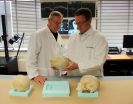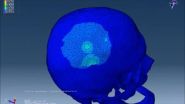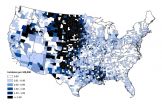'Fracture' prints, not fingerprints, help solve child abuse cases
2015-05-07
(Press-News.org) EAST LANSING, Mich. - Much like a finger leaves its own unique print to help identify a person, researchers are now discovering that skull fractures leave certain signatures that can help investigators better determine what caused the injury.
Implications from the Michigan State University research could help with the determination of truth in child abuse cases, potentially resulting in very different outcomes.
Until now, multiple skull fractures meant several points of impact to the head and often were thought to suggest child abuse.
Roger Haut, a University Distinguished Professor in biomechanics, and Todd Fenton, a forensic anthropologist, have now proven this theory false. They've found that a single blow to the head not only causes one fracture, but may also cause several, unconnected fractures in the skull. Additionally, they've discovered that not all fractures start at the point of impact - some actually may begin in a remote location and travel back toward the impact site.
The team's findings were recently presented at the annual meeting of the American Academy of Forensic Sciences.
"It's a bit like smashing raw hamburger into a patty on the grill," Haut said. "When you press down on the meat to flatten it, all the edges crack. That's what can happen when a head injury occurs."
Because piglet skulls have similar mechanical properties as infant human skulls - meaning they bend and break in similar ways - Haut and Fenton used the already deceased specimens in their research and found they were able to classify the different fracture patterns with a high degree of accuracy.
"Our impact scenarios on the piglet skulls gave us about an 82 percent accuracy rate, while on the older skulls, it improved to about 95 percent," Fenton said.
To help them get to this level of accuracy, both researchers teamed up with Anil Jain, a University Distinguished Professor in computer science and engineering at MSU, to develop a mathematical algorithm to help classify the fractures.
"A major issue in child death cases is you never really know what happened," Haut said. "The prosecutor may have one idea, the medical examiner another, and the defendant a completely different scenario."
Fenton and Haut's close relationship with medical examiners often results in them being called upon in certain, hard-to-determine cases. They've used this new knowledge to help solve these cases, but both are also looking to use Jain's algorithm in an online resource that will provide even more assistance to investigators.
The team is currently developing a database, or Fracture Printing Interface, that will allow forensic anthropologists and investigators to upload human fracture patterns from different abuse cases and help them determine what most likely caused an injury.
"We will never know with 100 percent probability what happened in many of these cases, but this interface will give us a higher chance of figuring that out," Haut said.
INFORMATION:
Their research has been funded through multiple grants from the National Institute of Justice.
Michigan State University has been working to advance the common good in uncommon ways for more than 150 years. One of the top research universities in the world, MSU focuses its vast resources on creating solutions to some of the world's most pressing challenges, while providing life-changing opportunities to a diverse and inclusive academic community through more than 200 programs of study in 17 degree-granting colleges.
[Attachments] See images for this press release:


ELSE PRESS RELEASES FROM THIS DATE:
2015-05-07
PULLMAN, Wash.--Washington State University researchers say the popularity of bamboo landscaping could increase the spread of hantavirus, with the plant's prolific seed production creating a population boom among seed-eating deer mice that carry the disease.
Richard Mack, an ecologist in WSU's School of Biological Sciences, details how an outbreak could happen in a recent issue of the online journal PLOS One.
Bamboo plants are growing in popularity, judging by the increased number of species listed by the American Bamboo Society. Some grow in relatively self-contained ...
2015-05-07
WASHINGTON -- Can a true, robust global health framework be created to help prevent tragedies like Ebola while at the same time allow countries to meet everyday health needs?
Georgetown University global health and law experts say it can be done, and in a special issue of "The Lancet" focusing on global health security, they propose specific priorities to transform a fragmented health system into a "purposeful, organized" framework with national health systems at its foundation and an empowered World Health Organization at its apex.
"The Ebola epidemic in west Africa ...
2015-05-07
The west African Ebola epidemic has rekindled interest in global health security, but it has also highlighted a troubling lack of political commitment to public health, and it is far from clear whether the crisis will be enough to rejuvenate global health security, say leading global health experts writing in The Lancet.
Through a series of essays [1], the review, which is published as part of a special issue on global health security, explores different perspectives on the wider lessons that can be drawn from the outbreak, including how it has demonstrated the importance ...
2015-05-07
Your genes may influence how sensitive you are to emotional information, according to new research by a UBC neuroscientist. The study, recently published in The Journal of Neuroscience, found that carriers of a certain genetic variation perceived positive and negative images more vividly, and had heightened activity in certain brain regions.
"People really do see the world differently," says lead author Rebecca Todd, a professor in UBC's Department of Psychology. "For people with this gene variation, the emotionally relevant things in the world stand out much more."
The ...
2015-05-07
For faster, longer-lasting water filters, some scientists are looking to graphene --thin, strong sheets of carbon -- to serve as ultrathin membranes, filtering out contaminants to quickly purify high volumes of water.
Graphene's unique properties make it a potentially ideal membrane for water filtration or desalination. But there's been one main drawback to its wider use: Making membranes in one-atom-thick layers of graphene is a meticulous process that can tear the thin material -- creating defects through which contaminants can leak.
Now engineers at MIT, Oak Ridge ...
2015-05-07
BOULDER--New research has identified correlations between weather conditions and the occurrence of West Nile virus disease in the United States, raising the possibility of being able to better predict outbreaks.
The study, by researchers with the National Center for Atmospheric Research (NCAR) and the Centers for Disease Control and Prevention (CDC), finds strong correlations across much of the country between an increased occurrence of West Nile virus disease and above average temperatures in the preceding year. The scientists also find that precipitation influences ...
2015-05-07
Latin American women in Los Angeles County are twice as likely as white women to contract cervical cancer, according to the Los Angeles County Department of Public Health, and are significantly less likely to be educated about the causes of the disease or to be screened for it.
That needs to change, say USC researchers, who are finding ways to make it happen.
"Latinas are the ones most at risk and yet health communication campaigns still essentially target white women," said Sheila Murphy, professor at the USC Annenberg School for Communication and Journalism.
Murphy ...
2015-05-07
Researchers at the RIKEN Brain Science Institute have uncovered a new mechanism for the regulation of blood pressure. Published in Molecular Cell, the study links events at the single-cell level to a system-level effect, showing that blood pressure can drop dramatically if the protein ERAP1 is released from cells and enters the blood stream.
Because high blood pressure is a primary risk factor for stroke, heart disease, and diabetes, understanding how our bodies naturally regulate blood pressure is essential for developing treatments that help keep it at normal levels. ...
2015-05-07
A study, published today in Cell, demonstrates the power of organoids to capture, in three dimensions, the multiple mutations that occur in tumours. Organoids, small clusters of cells that accurately mimic the behaviour of human tissue, can be used to test cancer drugs and, eventually, to identify effective personalised treatments for patients.
Until now, cancer drug screening has primarily been carried out using two-dimensional cell lines grown in dishes, or in mouse models. Organoids, which more closely resemble human tumours than cell lines, and are less time and ...
2015-05-07
Researchers at University of California, San Diego School of Medicine and Shiley Eye Institute have identified the molecular "glue" that builds the brain connections that keep visual images clear and still, even as objects or your eyes move. Using mouse models, the researchers demonstrate that image stabilization depends upon two proteins, Contactin-4 and amyloid precursor protein, binding during embryonic development. The study is published May 7 by Neuron.
"In the visual system, precise connections between your eyes and brain help you see specific things and make sure ...
LAST 30 PRESS RELEASES:
[Press-News.org] 'Fracture' prints, not fingerprints, help solve child abuse cases


